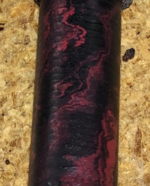Hey Danny
I read a bit more about ebonite turning on a couple of sites and there seemed to be a consensus that ebonite is very hard on carbide for some reason and a couple people recommended using PCD inserts instead. I may experiment with grinding some HSS to make a flat scraper and see how that does. I concur with your observation that chattering is a problem; I was turning a relatively long (150 mm) piece of 18 mm ebonite, and even with tailstock support was getting bad chattering in the middle of the stock at medium to high speed; much better at low speed. Maybe a combination of the round carbide insert tool for roughing and a flat scraper for final surface prep may work the best. It seems that ebonite may be the worst of materials in terms of being abrasive enough to wear down even carbide quickly but not rigid enough to turn without flex and chatter

. Hopefully I'll be able to try the round insert tool on some other materials soon (I've got some nice brass and some drill rod to try out), maybe even some wood! I'll report back.
Thanks again, really nice work.
Fred

